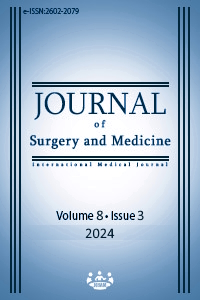HRCT severity score as a predictive biomarker in severity assessment of COVID-19 patients
HRCT severity score in severity assessment of COVID-19 patients
Keywords:
Coronavirus, COVID-19, CT severity score, High-resolution computed tomography, Western NepalAbstract
Background/Aim: In 2020, the World Health Organization declared the Coronavirus disease of 2019 (COVID-19) a pandemic due to its widespread nature. The severity of COVID-19 infections leading to patient deaths is influenced by various factors. Therefore, it is crucial to identify and address these contributing causes for effective treatment of COVID-19.
Methods: This study was conducted between 23 January 2021 and 19 June 2021 at a hospital with 100 beds in Western Nepal. Patient demographic data and High-resolution computed tomography severity scores were recorded. Microsoft Excel and Statistical Package for the Social Sciences were used for statistical data analysis. Binomial regression and Chi-square tests were applied, setting the significance level at P<0.05 with a confidence interval of 95%.
Results: The study found a significant association between computed tomography (CT) severity, gender, and age with the treatment outcome among COVID-19-infected patients admitted to the hospital. Patients with a CT severity score between 16 and 25 had an eightfold higher mortality rate (OR: -8.802; 95% CI: 3.506–18.491).
Conclusion: The severity and mortality of COVID-19 infections are influenced by factors such as age, gender, and biomarkers indicated by CT severity scores. Identifying additional factors that worsen COVID-19 patient’s conditions and increase the risk of mortality is essential.
Downloads
References
Yang R, Li X, Liu H, Zhen Y, Zhang X, Xiong Q, et al. Chest CT severity score: an imaging tool for assessing severe COVID-19. Radiology: Cardiothoracic Imaging. 2020;2(2):e200047. doi: 10.1148/ryct.2020200047 DOI: https://doi.org/10.1148/ryct.2020200047
Abdel-Tawab M, Basha MA, Mohamed IA, Ibrahim HM. A simple chest CT score for assessing the severity of pulmonary involvement in COVID-19. Egypt J Radiol Nucl Med. 2021;52(1):1-0. doi: 10.1186/s43055-021-00525-x DOI: https://doi.org/10.1186/s43055-021-00525-x
Biomarkers Definitions Working Group, Atkinson Jr AJ, Colburn WA, DeGruttola VG, DeMets DL, Downing GJ, et al. Biomarkers and surrogate endpoints: preferred definitions and conceptual framework. Clin Pharm Therap. 2001;69(3):89-95. doi: 10.1067/mcp.2001.113989 DOI: https://doi.org/10.1067/mcp.2001.113989
Rahman MH, Amir N, Rahman MA, Islam AT, Islam MS, Huda MD, et al. Role of HRCT scan of chest in the evaluation of COVID-19 Pneumonia. TAJ: J Teach Assoc. 2021;34(1):109-14. doi: 10.3329/TAJ.V34I1.54914 DOI: https://doi.org/10.3329/taj.v34i1.54914
Saeed GA, Gaba W, Shah A, Al Helali AA, Raidullah E, Al Ali AB, et al. Correlation between chest CT severity scores and the clinical parameters of adult patients with COVID-19 pneumonia. Radiol Res Pract. 2021;2021. doi: 10.1155/2021/6697677 DOI: https://doi.org/10.1155/2021/6697677
Kim JH, Ta CN, Liu C, Sung C, Butler AM, Stewart LA, et al. Towards clinical data-driven eligibility criteria optimization for interventional COVID-19 clinical trials. J Am Med Inform Assoc. 2021;28(1):14-22. doi: 10.1093/jamia/ocaa276 DOI: https://doi.org/10.1093/jamia/ocaa276
Yasin R, Gomaa AA, Ghazy T, Hassanein SA, latif Ibrahem RA, Khalifa MH. Predicting lung fibrosis in post-COVID-19 patients after discharge with follow-up chest CT findings. Egypt J Radiol Nucl Med. 2021;52(1):1-3. doi: 10.1186/s43055-021-00495-0 DOI: https://doi.org/10.1186/s43055-021-00495-0
Ye C, Zhang S, Zhang X, Cai H, Gu J, Lian J, et al. Impact of comorbidities on patients with COVID‐19: A large retrospective study in Zhejiang, China. J Med Virol. 2020;92(11):2821-9. doi: 10.1002/jmv.26183] DOI: https://doi.org/10.1002/jmv.26183
Li K, Wu J, Wu F, Guo D, Chen L, Fang Z, et al. The clinical and chest CT features associated with severe and critical COVID-19 pneumonia. Invest Radiol. 2020;55(6):327-31. doi:.10.1097/rli.0000000000000672 DOI: https://doi.org/10.1097/RLI.0000000000000672
Karki D, Saksham KC, Gurung R, Adhikari S. Association of HRCT severity score, pre-existing comorbidities, and ABO blood group with treatment outcomes of COVID-19 patients admitted in a hospital of Western Nepal. Asian J Med Sci. 2022;13(4):1-6. doi: 10.3126/ajms.v13i4.42468 DOI: https://doi.org/10.3126/ajms.v13i4.42468
Karki D, Gurung R, Nepali P, Kaphle HP, Subedi B, Adhikari S. Raised D-dimer among Admitted COVID-19 Patients in a Tertiary Care Centre: A Descriptive Cross-sectional study. JNMA: J Nepal Med Assoc. 2022;60(251):596. doi: 10.31729/jnma.7579 DOI: https://doi.org/10.31729/jnma.7579
Ponti G, Maccaferri M, Cristel R, Tomasi A, Ozben T. Biomarkers associated with Covid-19 disease progression. Crit Rev Clin Lab Sci. 2020;57(6):389-99. doi: 10.1080/10408363.2020.1770685 DOI: https://doi.org/10.1080/10408363.2020.1770685
Yazar H, Kayacan Y, Özdin M. Investigation of C-reactive Protein and D-dimer Findings in Patients with COVID-19. Bezmialem Science. 2021;9(Supplement 1):4-8. DOI: https://doi.org/10.14235/bas.galenos.2020.4884
Wambier CG, Goren A. Severe acute respiratory syndrome coronavirus 2 (SARS-CoV-2) infection is likely to be androgen mediated. J Am Acad Dermatol. 2020;83(1):308-9. doi: 10.1016/j.jaad.2020.04.032 DOI: https://doi.org/10.1016/j.jaad.2020.04.032
Jaillon S, Berthenet K, Garlanda C. Sexual dimorphism in innate immunity. Clin Rev Allergy Immunol. 2019;56(3):308-21. doi: 10.1007/s12016-017-8648-x DOI: https://doi.org/10.1007/s12016-017-8648-x
Davies NG, Klepac P, Liu Y, Prem K, Jit M, Eggo RM. Age-dependent effects in the transmission and control of COVID-19 epidemics. Nat Med. 2020;26(8):1205-11. doi: 10.1038/s41591-020-0962-9 DOI: https://doi.org/10.1038/s41591-020-0962-9
Yilmaz A, Sabirli R, Seyit M, Ozen M, Oskay A, Cakmak V, et al. Association between laboratory parameters and CT severity in patients infected with Covid-19: A retrospective, observational study. Am J Emerg Med. 2021;42:110-4. doi: 10.1016/j.ajem.2021.01.040 DOI: https://doi.org/10.1016/j.ajem.2021.01.040
Zhang L, Yan X, Fan Q, Liu H, Liu X, Liu Z, et al. D‐dimer levels on admission to predict in‐hospital mortality in patients with COVID-19. J Tromb Haemost. 2020;18(6):1324-9. doi: 10.1111/jth.14859 DOI: https://doi.org/10.1111/jth.14859
Cummings MJ, Baldwin MR, Abrams D, Jacobson SD, Meyer BJ, Balough EM, et al. Epidemiology, clinical course, and outcomes of critically ill adults with COVID-19 in New York City: a prospective cohort study. Lancet. 2020;395(10239):1763-70. doi: 10.1016/S0140-6736(20)31189-2 DOI: https://doi.org/10.1016/S0140-6736(20)31189-2
Downloads
- 528 577
Published
Issue
Section
How to Cite
License
Copyright (c) 2024 Dipesh Karki, Sundar Adhikari
This work is licensed under a Creative Commons Attribution-NonCommercial-NoDerivatives 4.0 International License.
















